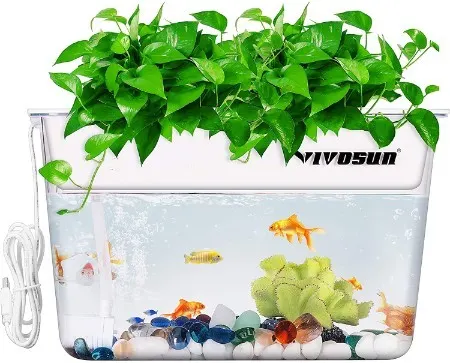The world of food and agriculture has changed a lot over time. Most of the foods we consume nowadays are full of chemicals that, in one way or another, affect our bodies. One of the most efficient ways to create a symbiotic
But what if there is a way to grow your fresh plants even with the limited space of urban settings? Is there a way you can personally manage and oversee which chemicals you expose your plants to?
Well, the answer lies in aquaponics farming. With aquaponics, space isn’t a big deal, and you get to enjoy fresh vegetables and fruits grown in your own garden.
Also, the process allows you to grow the plants organically without synthetic fertilizers and forever chemicals. Sounds amazing. Well, today, we present some of the best Aquaponic greenhouse kits to make this amazing idea a reality!
Best-Of by Category
| Category | Product |
|---|---|
| Best for Indoor | Back to the Roots Indoor Garden |
| Best for Aquaponics Beginners | AquaSprouts Garden |
| Best Hydroponic and Aquaponic System | Huamuyu Hydroponic Garden Aquaponics Fish Tank Plants Growing System |
| Best for Small Spaces | Penn-Plax Aquaponic Betta Fish Tank |
Best Aquaponics Greenhouse Kits for Homes
1. Back to the Roots Indoor Garden
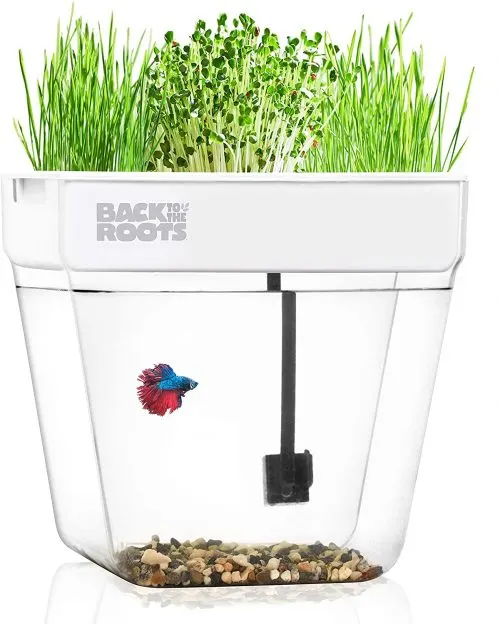
This excellent aquaponics system is 13.4 by 13.4 by 9.5 inches. This mini aquaponics greenhouse system allows you to grow plants while simultaneously rearing aquatic life. If you want to bring more light and glamour to an indoor space, this aquaponics kit does it perfectly.
It’s a sleek, self-watering kit that allows you to grow various houseplants with little hassle. And you can even customize the tank’s interior to create the best underwater scene.
The aquaponic ecosystem works in the same way as the rest of the other kits on this list. The fish eats and excretes, the microbes convert this waste into nitrates, which plants need for growth, and the plants release oxygen, which the fish use for breathing. Simple symbiosis!
What I like about this aquaponic system:
- Offers an all-year-round presence of green plants in the house.
- Ideal for several plants, including succulents and other houseplants.
- Fits in small spaces, which is most common in urban settings.
- Easy to set up and provides ideal conditions for faster plant growth.
- Can be a unique home décor or gift item.
- Made in the US with a free replacement or 100% money refund guarantee.
- The kit includes free lessons on hydroponic and aquaponic systems.
The Water Garden package includes:
- Organic Microgreen Seeds
- Growstones,
- D-Klor & Zym-Bac
- Fish Food
See Related: Best Greenhouses to Buy Today
2. AquaSprouts Garden
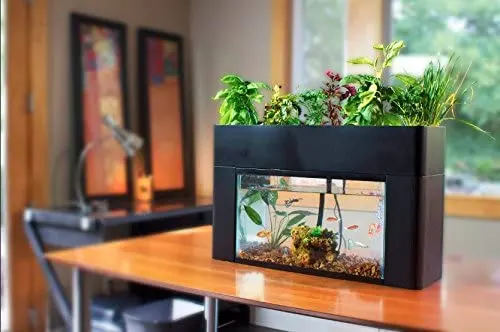
Picture a living ecosystem in your house, where plants and aquatic life can thrive – just like in a natural ecosystem. This 24 pounds, 28 by 8 by 17 inches aquaponics kit makes it possible.
It allows you to grow healthy plants through a symbiotic relationship between fish, microbes, and plants. Plants keep the water clean by taking in the nutrients produced by fish as excretes.
What makes the kit awesome?
- It’s a self-sustaining aquaponics kit ideal for home, school, or office settings.
- Supports a variety of plants, including vegetables, herbs, flowers, succulents, etc.
- The kit gives you a chance to learn how the natural ecosystem works.
- Plants here grow faster than in the natural ecosystem, and you can have green plants all year round.
See Related: Best Shelves for a Greenhouse
3. Huamuyu Hydroponic Garden Aquaponics Fish Tank Plants Growing System
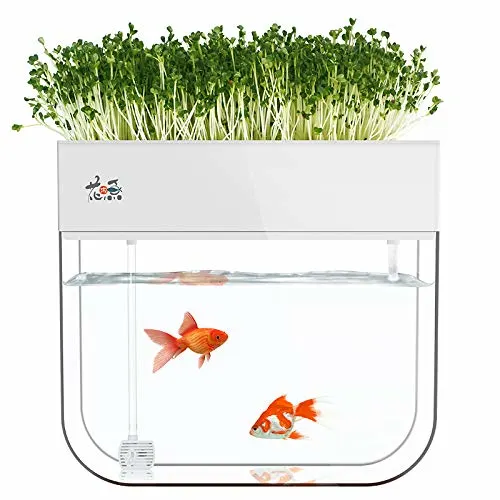
If you want it medium, this aquaponic kit suits you well. This Huamuyu aquaponic kit measures 12.2 inches by 7.7 inches by 11.0 inches and can hold up to 3 gallons of water.
It’s made using a sturdy clear plastic material, meaning that you don’t need to worry about it breaking. Also, the kit has an attractive design, which will certainly add appeal to your interior.
What I like most about this aquaponics kit is that it has a self-cleaning system. This system reduces the amount of cleaning needed by around 50% compared to conventional fish tanks.
Other notable features include:
- Siphon oxygen supply – includes an automatic siphon design, where the plant’s roots breathe regularly and don’t require fertilizer or watering. The fish also get a fresh oxygen supply through 2-minute cycles that offer a natural experience in the fish tank.
- Plants variety – the kit allows you to grow various plant types, right from vegetables, flowers, and other plants.
- It is easy to set up or install.
- Enables fresh produce supply all year round in limited spaces.
Some crucial things to note:
- The kit is ideal for 2-3” long fish, as shorter ones might be sucked through the pump.
- Don’t grow spicy or toxic plants that might affect your fish.
- When installing, allow the kit to run for several days before putting in the fish – avoid using fresh tap water.
See Related: Best Lean To Greenhouses | Side of House Options
4. Penn-Plax Aquaponic Betta Fish Tank
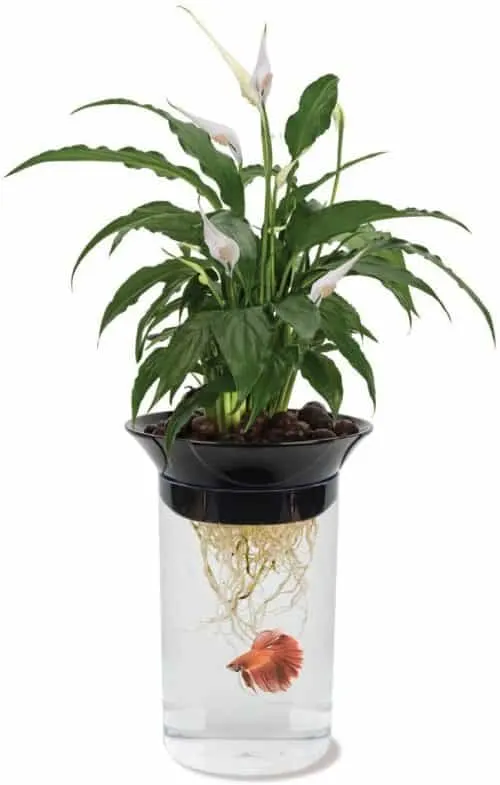
This 1.2 pounds, 3 by 3 by 8.6 inches kit, is a simple mini aquaponics system that allows you to nurture both fish and plants in one setting. Since it’s a small system that can’t produce enough vegetables or fruits, you can use it to grow flowers and help the kids or young hobbyists learn about the symbiotic relationship between fish and plants.
What I like about this Aquaponic Fish Tank:
- Has an easy-to-clean tank and planter that detaches pretty easily.
- Plants flourishes from the fish excrete, and no wastage or need for extra nutrients.
- The fish uses oxygen produced by the plants.
- It can easily be used to grow plants only even without the fish.
- Ceramic planting material that helps in water retention, and supports plant growth.
This aquaponics greenhouse kit not only creates a symbiotic environment for the fish and plants, but it also adds natural charm to your home – from the plants, fish, and the kit’s design.
See Related: Best Outdoor Jobs | Careers to Consider for Outdoor Lovers
5. Penn-Plax AquaTerrium Planting Tank
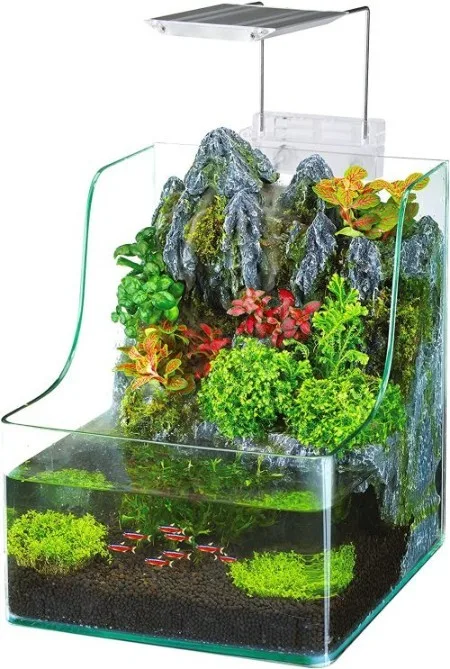
Now, this one comes with some of the most stunning features to light up your house or office!
Besides giving you a chance to experience nature in your own house, its alluring design goes pretty well with almost any interior design. The best thing is that your fish and plants can grow in a symbiotic environment, which allows for faster growth than even their natural environment.
What draws me to the Aquaterrium Planting Tank?
- A beautiful design that consists of a rock-like landscape, a flowing waterfall, and some exclusive artificial plants.
- An LED fixture that provides sun-like light to the plants for better growth.
- A clear glass tank with a distinct fish aquarium.
- An integrated water filter that helps to maintain fresh aquarium water for healthy fish.
- It’s ideal for various types of plants, including watercress, herbs, jade, etc.
- The aquarium is ideal for various small fish, including goldfish, zebras, guppies, etc.
To get the nutrients to the plants, this aquaponics kit uses a pump to circulate the water. Clean oxygenated water flows back to the aquarium through the cascading waterfall.
This is one of the best aquaponics greenhouse kits on this list, and that can fit anywhere – whether on a tabletop, desk, or even a dresser.
See Related: Best Glass Greenhouses in 2023
6. VIVOSUN 3-Gallon Aquaponic Fish Tank
This Aquaponic kit supports both the fish and plants, this 3-gallon tank is one of the most straightforward aquaponics systems to use. The best thing about it is that you can use different types of plants in it – including vegetables and herbs.
This small aquaponics kit weighs only 1.65 pounds and measures 14.17 x 9.06 x 8.46 inches, which means it can fit even on your office desk or countertop without taking up much space. Since it’s a self-sustaining system, little maintenance is required once you set it up.
This tank includes a self-cleaning system and a siphon system. This ensures the plants are properly aerated with oxygen, this, in turn, sustains the fish in a natural environment within the kit.
Additionally, it’s equipped with a thermometer to help monitor temperature fluctuations for your fish and plants.
Some notable features of this VIVOSUN 3-Gallon Aquaponic Fish Tank:
- Different media baskets for different plant types.
- Special bacteria colonies help in the breakdown of fish waste.
- A small air pump for aeration and oxygenation.
- An adjustable water flow knob to control the water flowing to the plants.
This is one of the most user-friendly aquaponics greenhouse kits as it comes with almost everything you need to get started. All you need is to add fish and plants, and you’re good to go.
See Related: Best Greenhouse Floors to Buy Today
Benefits and Drawbacks of Greenhouse Aquaponics
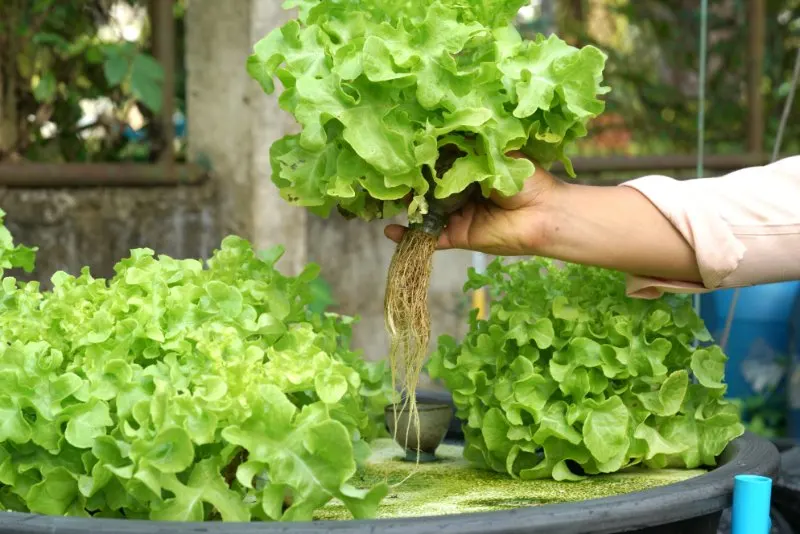
The Benefits of Aquaponics Greenhouses
The benefits that come with this farming practice are just too many.
- First, it doesn’t require a lot of space for you to set up your farm. You can have a small-scale farm in your backyard or even in the comfort of your living room.
- Aquaponic systems are energy-efficient and conserve water. In a hydroponics system, for instance, the plants take up only 10% of the water used, compared to 50-80% in Aquaponics.
- Moreover, since no soil is involved, there is little to no chance of soil-borne diseases affecting your plants. And if they do occur, they are quickly contained since the system is open and visible.
- Weed growth is also significantly minimized in this system compared to soil use. And in case they do occur, they are easy to remove.
- Plants grown in aquaponics systems absorb more nutrients from fish waste than in soil. This means using grow lights will not facilitate unwanted algae growth.
- Another benefit of this system is that you can grow plants and rear fish all year round. The temperature and other conditions in aquaponics greenhouses can be controlled to suit the needs of your plants and animals. This way, you get a steady supply of fresh produce and fish all year!
See Related: Greenhouse Cost Guide
Drawbacks to using Aquaponics Greenhouse kits
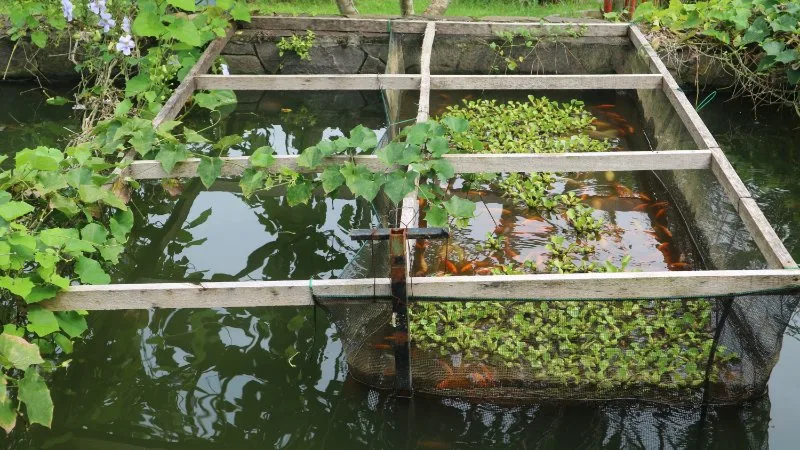
Like any other farming system, greenhouse aquaponics comes with some disadvantages.
- Aquaponics is a great way to grow your food, but setting up a commercial-scale system can be expensive. If you’re interested in starting an aquaponics business, invest in a large greenhouse structure, tanks, pumps, and other equipment.
- Aquaponics requires electricity. Aquaponics systems need to be aerated and circulated using pumps, which require electricity to run.
- Aquaponics systems can be complicated to set up. The complex systems require knowledge of plumbing, electricity, and hydraulics to set up correctly. If you’re unfamiliar with these systems, hiring someone to set up your aquaponics kit for you might be best.
Now that you know the pros and cons of using aquaponics greenhouse kits, you can decide if this system is right for you. If you have the space and resources to invest in a commercial-scale system, aquaponics could be a great way to grow your food. However, aquaponics might not be the best option for you if you’re not interested in starting a business.
Commercial Aquaponic Kits
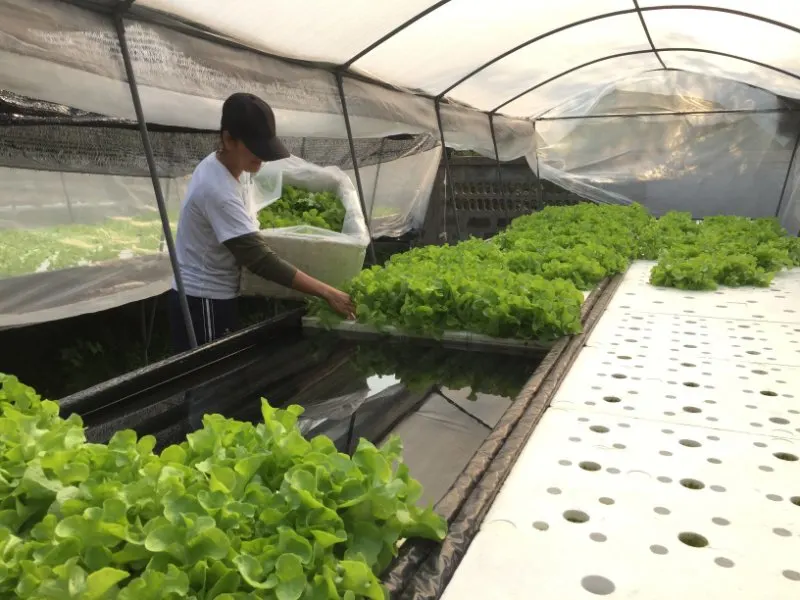
This method of growing plants and fish in the same system isn’t only available for small scale. You can also do it commercially. However, for commercial purposes, you need a larger space to allow the growth of more plants and fish.
That is where large aquaponic greenhouses come into play, most of which are customized based on your needs. So, if you are looking for a larger commercial aquaponics greenhouse kit, you can click here to pick an aquaponic greenhouse design and instructions that can help you establish your own aquaponics greenhouse environment with a proper electrical design.
What is Aquaponics Farming? How does it work?
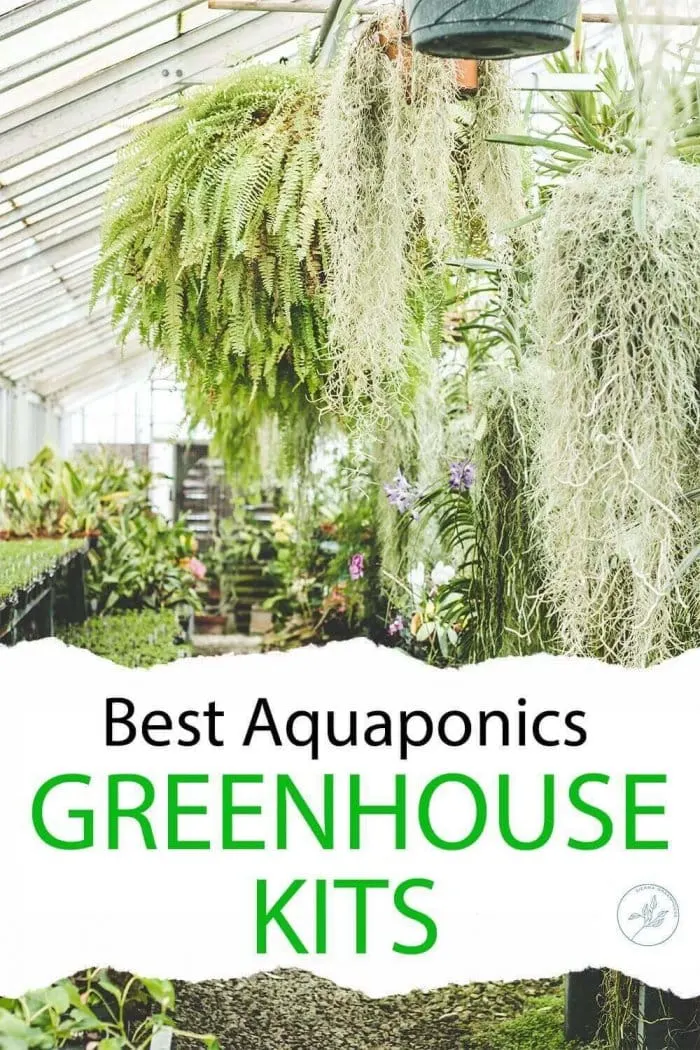
Dating back as early as 5 AD, aquaponics is not a new farming practice. However, with most farmers around the world adopting different methods with the evolution of agricultural technology, this practice disappeared on a wide scale for a good number of years.
It has, however, gained a comeback in recent years, at a time when farming space is scarce, and people are more drawn to organic farming. So, what is this aquaponics farming practice?
Typically, it involves growing plants and rearing aquatic life (fish, snails, prawns/shrimp, crayfish, etc.) in the same system. The practice is soil-less and uses no synthetic chemicals. This way, you get to grow fresh, organic produce, either small scale or large scale.
Aquaponics involves the integration of hydroponics and aquaculture practices.
The system relies on the symbiotic relationship between aquatic life and plants. Firstly, the animals in the water (for instance, fish), eat, breed, and excrete in the water. And since the excretion brings about ammonia, which might be toxic to the fish, nitrifying bacteria comes in.
The bacteria convert the ammonia into nitrates, which the plants in the other chamber will use for growth. In return, the plants will produce oxygen gas, which the fish will need. These two chambers are interconnected in a way that ensures easy transfer of nutrient-rich water to the plants and oxygen-rich water back to the fish tank.
In general, one organism’s by-product becomes the much-needed nourishment for the other. Now, away from all the theory! What are the best aquaponic greenhouse kits to help you achieve your indoor garden desire?
Things to consider before purchasing an Aquaponics Greenhouse Kit
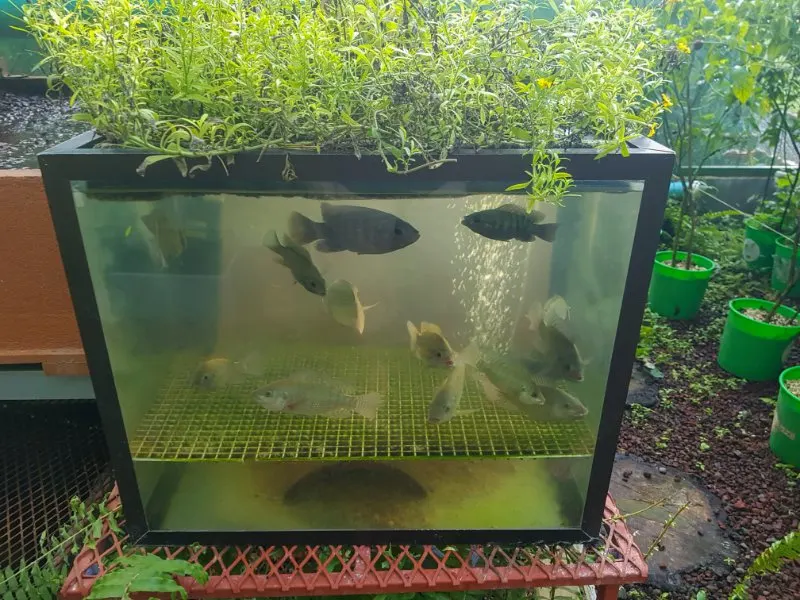
How much space do I have?
Aquaponics systems can be large or small but typically require more space than traditional farming methods. If you don-scale, systems can be expensive to set up. If you’re not interested in starting a business, you might want to consider a smaller aquaponics system for your home.
How much time can I dedicate to maintenance?
Aquaponics systems require regular maintenance, including cleaning the tanks and monitoring water quality. If you don’t have time to dedicate to these tasks, you might want to consider a different type of gardening method.
What type of plants and fish do I want to grow?
You’ll need to choose the right plants and fish for your climate and aquaponics system. Make sure you research the types of plants and fish that are best suited for aquaponics before making your purchase.
Once you have decided on the size and type of system you want, it is time to choose a kit. There are many different kits available on the market, so it is important to compare features and prices before making a purchase.
We hope our list of the best aquaponics greenhouse kits has offered you some incredible options. And that you can now pick one that fits your needs based on the above information.
FAQs
Can you use aquaponics in a greenhouse?
Yes, aquaponics can be used in a greenhouse. A greenhouse could be helpful to keep your aquaponics kit in good condition if you are in cold climates.
What is the best fish for aquaponics?
There are many different types of fish that can be used for aquaponics. Some of the most popular edible fish include tilapia, catfish, and trout. For small-scale kits, look into freshwater shrimp.
How long does it take to set up an aquaponics system?
Setting up an aquaponics system usually takes around 2-3 days. However, this will vary depending on the size and complexity of the system.
What type of greenhouse is best for aquaponics?
An aquaponics greenhouse is a type of greenhouse that is designed specifically for the purpose of growing plants and fish in a symbiotic system. The best type of greenhouse for aquaponics is one that provides ample space for both plants and fish, as well as proper ventilation and lighting.
Additionally, it is important to choose a greenhouse that is made from durable materials that can withstand the unique demands of an aquaponics system.
Related Resources:

